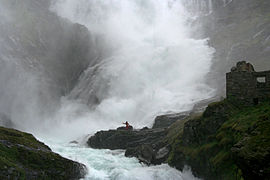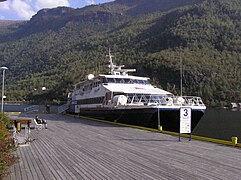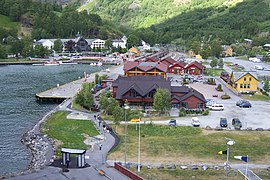| Parts of this article (those related to Complaints about and suggested curbs on tourism) need to be updated. The reason given is: Complaints are over 10 years old, needs updating. Please help update this article to reflect recent events or newly available information. (December 2024) |
Village in Western Norway, Norway
| Flåm | |
|---|---|
| Village | |
 View of Aurlandsvangen and Flåm View of Aurlandsvangen and Flåm | |
  | |
| Coordinates: 60°50′14″N 7°07′19″E / 60.8371°N 7.1219°E / 60.8371; 7.1219 | |
| Country | |
| Region | Western Norway |
| County | Vestland |
| District | Sogn |
| Municipality | Aurland Municipality |
| Elevation | 27 m (89 ft) |
| Population | |
| • Total | 350 |
| Time zone | UTC+01:00 (CET) |
| • Summer (DST) | UTC+02:00 (CEST) |
| Post Code | 5743 Flåm |
Flåm (Norwegian pronunciation: [floːm]) is a village in the Flåmsdalen valley which is located at the inner end of the Aurlandsfjorden, a branch of Sognefjorden. The village is located in Aurland Municipality in Vestland county, Norway. In 2014 its inhabitants numbered 350.
Name
The name Flåm is documented as early as 1340 as Flaam. It is derived from the plural dative form of the Old Norse word flá meaning "plain, flat piece of land", and it refers to the flood plains of the Flåm River. ("A plain between steep mountains" is the toponomy of the encyclopedia Store Norske Leksikon.)

History
In 1670 Flåm Church was built, replacing an older stave church.
In 1908, the Norwegian Parliament approved the construction of the Flåm Line railway, though the funds to construct the railway were not allocated until 1923. In 1942, regular operation of (steam-powered) trains started on the Flåm Line.
"In the 1960s, cruise ships stayed on the fjord" , according to Dagens Næringsliv.
In 2000, the "new pier" was referred to in a government document. ("The pier was built at the entrance to the new millennium", according to Dagens Næringsliv.)
Transportation
The closest airport is Sogndal Airport, Haukåsen, approximately 70 kilometres (43 mi) from Flåm.
The European route E16 highway between Oslo and Bergen runs through Flåm. The village sits about 7 kilometres (4.3 mi) southwest of the municipal centre of Aurlandsvangen, 12 kilometres (7.5 mi) south of the village of Undredal, and 15 kilometres (9.3 mi) east of the village of Gudvangen (through the Gudvanga Tunnel).
The Navvy road, Rallarvegen stretches from Myrdal down to Flåm. (Pedestrians and bicyclists still use it.) At Myrdal, it connects with the navvy road for the previously built Bergen Line.
Flåm is also connected by rail through the Flåm Line, a branch line of the Bergen Line.
Tourism
The village of Flåm has since the late 19th century been a tourist destination. It currently receives almost 450,000 visitors a year. Most ride the 20-kilometre (12 mi) Flåm Line between Flåm and Myrdal, one of the steepest railway tracks at 1 in 18 (not counting rack railways) in the world. There are also a few spirals. A former rail station building in Flåm now houses a museum dedicated to the Flåm railway.
The harbour of Flåm receives some 160 cruise ships per year.
Complaints about and suggested curbs on tourism
Air pollution in Flåm and Geiranger during the cruise season is similar to that of a big city. Cruise traffic in Norway, which is one of the largest exporters of oil in the world, emits more NOx than all road traffic in Norway combined. In a 2005 Bergens Tidende article, Kjetil Smørås (a hotel director and chairman of Fjord Norge said that "The cruise traffic pollutes more than several ten thousands of cars, and many of the worst ships sail up here (...) cruise tourists trod down the pristine Norwegian nature, and destroy the foundation for Vestlandet's four entries on Unesco's World Heritage lists".
In 2009, Jens Riisnæs (an author and NRK journalist) said "We have the world's most beautiful nation, we don't need to follow the cruise operators' premises. They can go other places with their polluting ships. It is unwanted noise."
In 2009, Dagens Næringsliv said that a report by Vestlandsforskning says that both "Flåm and Geiranger are nearing a limit in capacity. It might be an alternative and rather stand forth as a «relaxed», exclusive and somewhat less of a mass tourism, cruise destination."
In a 2014 Dagens Næringsliv article, a farmer said that "Previously the smell of summer was that of grass that had been cut. Now the smell is of heavy oil". Furthermore, "They talk about fish that has disappeared from the fjord. In Norway, cruise ships are permitted to dump overboard their greywater in the postcard-narrow fjord-arms. Furthermore, the news article says that defecation in public by tourists, is already a problem; the village's train station has the only public toilets, and 200,000 tourists are expected in the summer season.
In 2014, tourism professor Arvid Viken said that "it is about time this tourism is evaluated somewhat more soberly than how it has been done in many municipalities for some years". Furthermore, this tourism "has low profit per tourist, but is often associated with considerable costs for" the municipal administrations.
People
Flåm was the birthplace of the poet Per Sivle.
In media
Part of the book "The Ship of the Dead" is set in Flåm.
Media gallery
-
 Flåm Church, built in 1670
Flåm Church, built in 1670
-
 The Kjosfoss waterfall along the Flåmsbana, the railway line from Flåm to Myrdal
The Kjosfoss waterfall along the Flåmsbana, the railway line from Flåm to Myrdal
-
 Tourists at the railway station in Flåm. The station has the village's only public toilets
Tourists at the railway station in Flåm. The station has the village's only public toilets
-
 Flåm harbour
Flåm harbour
-
 A catamaran in Flåm harbour
A catamaran in Flåm harbour
-
 View of Aurlandsfjord and Flåm from a nearby summit
View of Aurlandsfjord and Flåm from a nearby summit
-
 View from Flåm
View from Flåm
-
 View of Flåm bridge with cruise ship behind
View of Flåm bridge with cruise ship behind
-
 Flåm harbour and railway station
Flåm harbour and railway station
-
 The SS Norway in Flåm
The SS Norway in Flåm
-
 The MSC Fantasia in Flåm
The MSC Fantasia in Flåm
-
 Ægir, a micro brewery and pub in a traditional-style building
Ægir, a micro brewery and pub in a traditional-style building
-
 P&O MV Britannia docked in Flåm
P&O MV Britannia docked in Flåm
-
 AIDAprima in Flåm
AIDAprima in Flåm
References
- "Drit og dra". 18 July 2014.
- "Flåm, Aurland (Vestland)". yr.no. Archived from the original on 2020-07-02. Retrieved 2020-01-25.
- ^ RUDJORD, ANNE FOUGNER HELSETH Foto og video: FARTEIN (2014-07-18). "Drit og dra". www.dn.no (in Norwegian). Retrieved 2022-12-02.
- Brekke, Arne. "Farm names in Flåm". Archived from the original on 9 June 2009. Retrieved 29 June 2008.
- Rygh, Oluf (1919). Norske gaardnavne: Nordre Bergenhus amt (in Norwegian) (12 ed.). Kristiania, Norge: W. C. Fabritius & sønners bogtrikkeri. p. 115.
- ^ Thorsnæs, Geir; Wisting, Tor (2022-01-24), "Flåmsbana", Store norske leksikon (in Norwegian Bokmål), retrieved 2022-12-02
- regionaldepartementet, Kommunal-og (2000-09-16). "Åpning av Fretheim hotell". 016061-090022 (in Norwegian). Retrieved 2022-12-02.
- "Railways Illustrated". June 2007. p. 67.
- "Key Facts on Flåm". VisitNorway.com. Archived from the original on 2006-10-17.
- Martiniussen, Erik (2019-06-07). "Cruiseflåten er fem ganger verre enn andre skip – og utslippene når land". Tu.no (in Norwegian). Retrieved 2021-01-10.
- Stensvold, Tore (2017-05-29). "Cruiseturister er i ferd med å ødelegge den uberørte naturen de kommer for å se. Her er tiltakene som kan redde norske fjorder". Tu.no (in Norwegian). Retrieved 2021-01-10.
- ^ "Strid i kjølvannet av cruiseturismen – DN.no". 2014-07-27. Archived from the original on 2014-07-27. Retrieved 2022-12-02.
- ^ Uvelkomne cruisegjester Archived 2014-08-12 at the Wayback Machine
External links
- Flåm webcam Archived 2017-11-14 at the Wayback Machine
- Visit Flåm